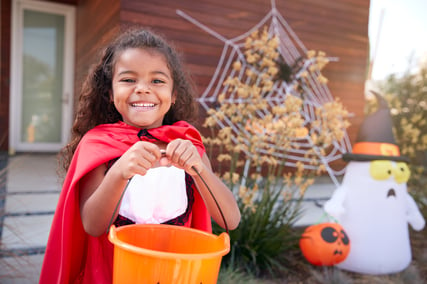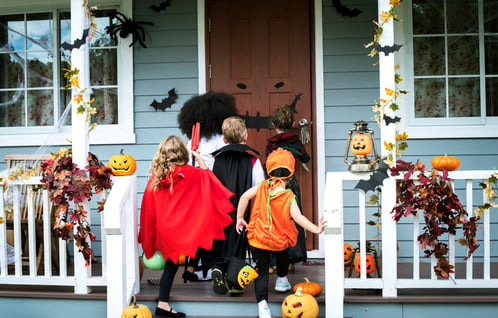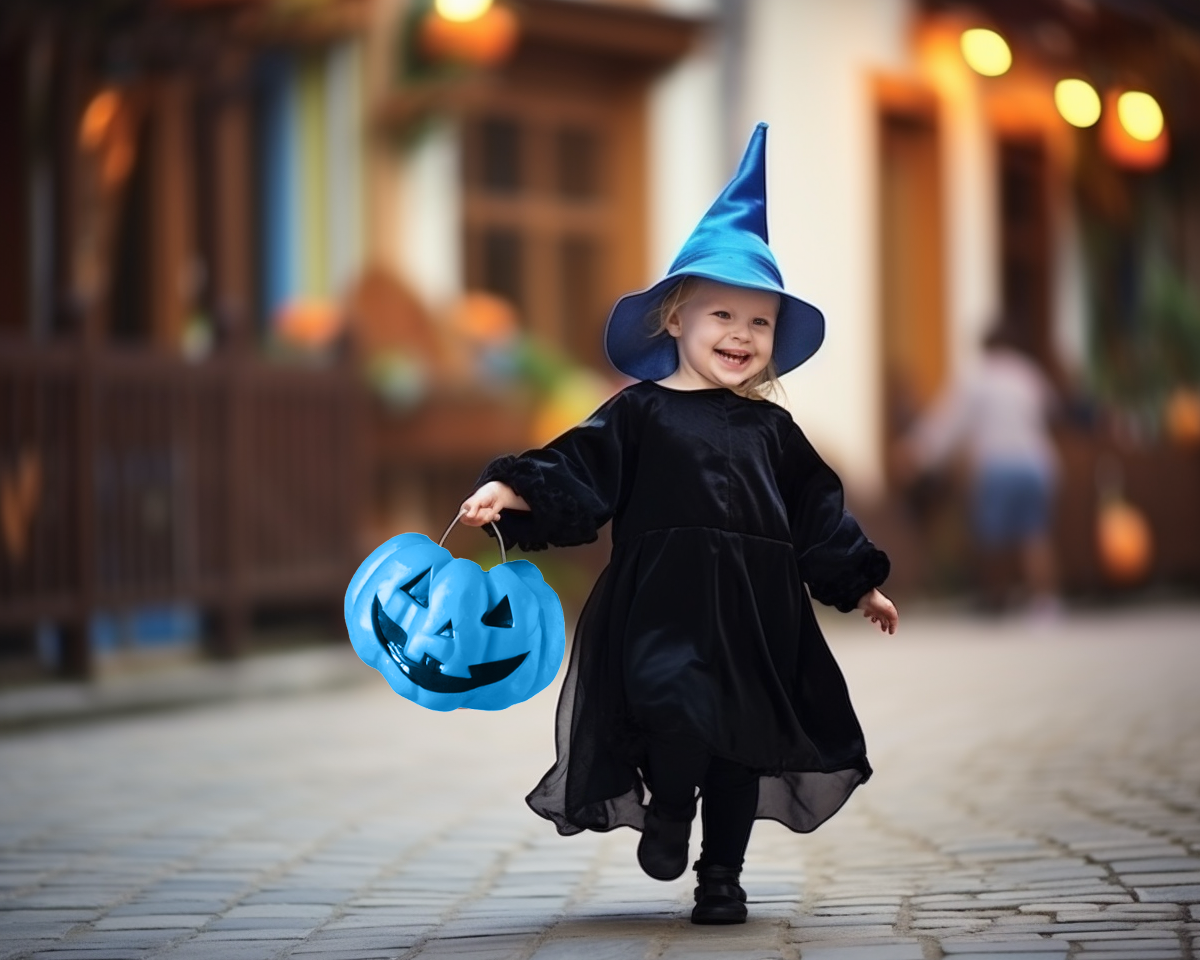Tricks for Making Halloween Enjoyable for Your Autistic Child
Many children love Halloween, but some autistic children find Halloween to be stressful and unenjoyable. The holiday boosts traditions that may be worry-invoking for some neurodivergent children. On Halloween, children often dress up in costumes. For autistic individuals, dressing up in a costume may cause the child to feel uncomfortable due to different textures or designs. Also, on Halloween, children will go door to door to trick or treat. The process of trick-or-treating puts lots of social demands on a child, and it can be challenging for autistic kids to handle new, unfamiliar situations.
Trick or treating can also be a problematic tradition for individuals with limited communication abilities. Another issue with Halloween that some children find stressful is the decorations and the changes to their daily environments and routines. Sometimes the decorations are terrifying and can cause some severe anxiety.
With that being said, there are ways we can make Halloween an enjoyable experience for our neurodivergent children.
Decorations
Typical Halloween decorations include flashing lights, unexpected movements, and loud or creepy noises. Decorations can be scary and overpowering for autistic children, especially if they have sensory issues. It’s essential to prepare your autistic child for the different situations they may face during Halloween. Here are some tips to prepare your child for the spooky Halloween decorations.
- Remind your child that the decorations are not real, and explain that it’s okay to feel scared, but the decorations can’t hurt them.
 Use social stories to outline the different types of decorations they may see during the Halloween season: Here’s a fun social story that focuses on Halloween.
Use social stories to outline the different types of decorations they may see during the Halloween season: Here’s a fun social story that focuses on Halloween. - Teach and expose your child to typical Halloween vocabulary to assist in labeling and expressing different types of decorations.
- Give your autistic child plenty of notice when decorating your house for Halloween.
- Avoid the overly scary decorated houses if you believe they will cause stress for your child.
- Prepare your child for decorating their house by showing pictures from previous years of the house decorated.
- Make the decorations in your house kid-friendly.
- Allow your child to help put up the Halloween decorations, let them explore the decorations to see how they function to ensure that they're not real objects.
Costumes
Wearing a costume is a common tradition on Halloween. Some costumes can interfere with mobility, are itchy, smell weird, are scary, and overwhelming. They can be especially problematic for ASD children with a sensory processing disorder. It’s essential that your child feels confident and comfortable in their Halloween costume. These tips will help them enjoy Halloween in their costume.
- Allow your child to explore their particular interests when picking out a Halloween costume. Parents, it’s time to show your creative side and let your child take the lead. Many autistic individuals have specific things that they enjoy most. It could be numbers, certain characters, animals, etc. It’s okay if your child wants an unconventional Halloween costume, embrace their idea, and they may have the most fabulous costume on the block.
 It’s important to ensure that your child is comfortable on Halloween. As parents, we need to consider our children’s sensory needs when picking up a costume from a party store. Many neurodivergent children struggle to process different sensory stimuli. Some costumes from stores may heighten your child’s sensory aversions and cause the child to feel unhappy. Certain brands are designing costumes specifically for children with disabilities.
It’s important to ensure that your child is comfortable on Halloween. As parents, we need to consider our children’s sensory needs when picking up a costume from a party store. Many neurodivergent children struggle to process different sensory stimuli. Some costumes from stores may heighten your child’s sensory aversions and cause the child to feel unhappy. Certain brands are designing costumes specifically for children with disabilities.
Target has created a great adaptive Halloween costume line, and the costumes are sensory-friendly. The costumes are made without itchy tags, have flat seams, and are made from soft materials. Also, the Target adaptive costumes come in favorite characters, such as Paw Patrol, Superheroes, Princesses, and more.
- It’s okay if your child doesn’t want to get into full costume for Halloween. There are different options available that may work for your neurodivergent child. They could wear a Halloween-themed shirt or pajamas, or they could wear a favorite character shirt. Costumes can be overwhelming, so it would be comforting for your child to allow them to choose specific pieces of the costume to wear or not wear. Importantly, don’t stress if your child doesn’t want to wear a costume at all. Your stress will undoubtedly cause your child to become anxious, so take the lack of costume in stride, and continue to enjoy the holiday.
Trick-or-Treating
Engaging in the tradition of trick-or-treating can be difficult for autistic kids, without even realizing the process of going door to door includes many embedded steps. Those steps may be problematic to children on the spectrum. The day of Halloween can be overwhelming. However, with the right support and these tips, trick-or-treating can be fun for any child.
- Prepare your child for trick-or-treating before Halloween. Practice at home or even in the neighborhood the steps that are included in trick-or-treating. Role-play and model acceptable greetings with your child, as well as waiting, how to knock on the door, how to choose candy, and how to accept the candy.
 Use a social story to support the topic of trick or treating. Many online Halloween social stories will help your child with the process of trick-or-treating, and you can also easily create your own specific social story with your child’s needs. Here’s a fun social story that focuses on trick-or-treating.
Use a social story to support the topic of trick or treating. Many online Halloween social stories will help your child with the process of trick-or-treating, and you can also easily create your own specific social story with your child’s needs. Here’s a fun social story that focuses on trick-or-treating.- Support your child through trick-or-treating by using schedules and visual supports. Some ASD children will require visuals to help them communicate while trick-or-treating.
- Choose a neighborhood for trick-or-treating that isn’t too crowded or chaotic. Ensure that the neighborhood is safe. I suggest going to an area that’s familiar to your child. Try to choose an environment that isn’t overwhelming or crowded.
- Don’t overdo it while trick-or-treating. It’s important to stick to your child’s schedule. Watch for cues that your child is tired or becoming overwhelmed. Being observant of your child’s signals will help to make the day more enjoyable.
- If you’re interested, invest in a Blue Pumpkin for trick-or-treating. A Blue Pumpkin signifies to others that your child might have specific needs related to autism.
Have a backup plan
I suggest having a backup plan in place for your neurodivergent child for Halloween. The day can be a lot, and your child may enjoy staying home to celebrate versus going out. Some children would rather skip the day altogether, and that’s okay too. Make the appropriate accommodations that will meet the needs of your child. Instead of following the traditional Halloween norms, you can try these tips to make it a special day for your child.
- Have a fun movie night instead. See if your child would be interested in watching a family-friendly Halloween movie. The Muppets Haunted Mansion, Spookily the Square Pumpkin, and Halloween Town are my favorite Halloween movies.
- Instead of trick or treating, allow your child to answer the door to hand out candy. Your child will be able to participate in the festivities from inside their own home.
- Complete Halloween fun craft projects with your child. Support your child’s sensory needs while incorporating a fun Halloween theme. Here’s a fun Halloween Slime recipe.
- Consider trick-or-treating around your house in different rooms and give your child sensory toys rather than candy.
My biggest tip is always to keep your child’s individual needs in mind when planning for Halloween. I hope your family has a Spooktacular Halloween!
What Halloween traditions are your favorites for neurodivergent kiddos?

Tatiana Tortora
Tatiana Tortora is a special education teacher in New York, specifically teaching students on the spectrum. She has her master’s degree in childhood education and students with disabilities. Tatiana is passionate about building understanding and acceptance of individuals with Autism.






